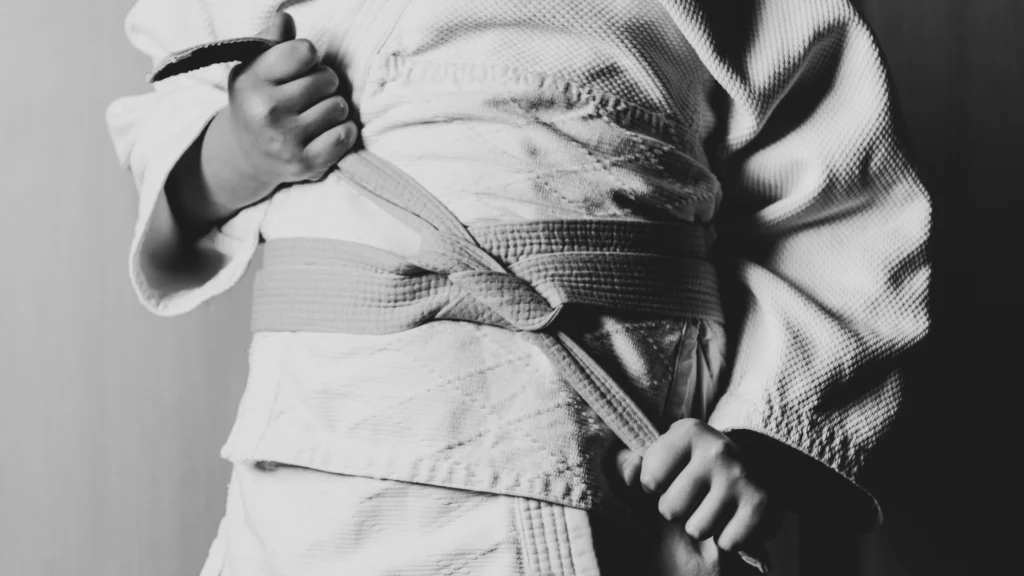Judo Belts: Meaning and Progression of Grades in Martial Arts
Everything You Need to Know About Judo Belts
In judo, the belts represent much more than a simple accessory: they are the tangible symbol of a practitioner's progression and commitment. Each judo belt testifies to the level of technical skill achieved and the personal path undertaken. The progression through the various grades is an essential part of judo practice, and includes a color scale that goes from white belt at the black belt. Every step in the judoka's path is marked by a new belt, which represents a milestone in understanding and mastering the techniques and principles of this ancient martial art. Let's discover together the meaning of each belt in judo and the progression of grades that characterizes this discipline.

Content index
The History of Belts in Judo

The belts in judo have a deep history, which dates back to the foundation of judo itself, thanks to Jigoro Kano. Kano introduced the system of judo belts as a method of distinguishing the skill and competence levels of practitioners.start, there were only two colors: black and white, but over time, more colors were added to reflect the different stages of learning. The system of judo belts It was later adopted by other martial arts, becoming a universal model of progression. judo belts Not only do they indicate technical mastery, but they also represent the athlete's commitment, discipline and personal growth along his or her path in judo.
For a complete insight into the birth and development of this martial art, you can read the article dedicated to history and philosophy of judo.
Judo Belt Colors: Meaning and Progression
In judo, the belt colors represent the different stages of learning and growth of the practitioner. Each judo belt has a specific meaning, which reflects the level of skill achieved and the progress made. The classic progression starts from white belt, which represents the beginner, and continues through the yellow, the orange, the green, the blue, the brown, up to the much sought-after black belt. Each step in the ladder of judo belts colors marks a greater understanding of techniques, a growth in mental discipline and a move towards mastery of the martial art. blue belt judo, for example, indicates an intermediate level, in which the practitioner has acquired a solid technical foundation and a deeper understanding of judo.
The importance of understanding the meaning and value of each judo belt color It goes beyond aesthetics: it is a visible representation of a judoka's journey to mastery.
The Black Belt in Judo: Symbol of Mastery

Reach the black belt in judo is considered one of the greatest achievements for a practitioner. However, obtaining the black belt does not mark the end of the journey, but rather the beginning of a new phase. The black belt is a symbol of technical mastery and discipline, but also reflects the responsibility to transmit the values and techniques of judo to others. The progression through the various dad (black belt levels) represents continued growth, both physical and mental.
Judo Black Belt: A Sign of Years of Dedication
For many, the black belt is not only a recognition of skill, but a sign of dedication to the philosophy of judo, which embraces respect, perseverance and the continuous pursuit of personal improvement. These fundamental values make the path to black belt one of the most enriching experiences in the world of martial arts.
The Path to Every Judo Belt

The journey to every judo belt It is a long and demanding process that requires dedication, constant practice and a progressive development of technical skills. Each belt represents an important stage, and the transition from one color to another occurs through technical exams and the demonstration of specific knowledge.
For the initial belts, such as the white and yellow, the focus is on learning the basics of judo: the first landing techniques (ukemi) and the first throws. As you progress, the level of difficulty increases. The intermediate belts, such as the blue belt, require greater mastery of throwing and immobilization techniques. The brown belts prepare practitioners for the exam for the black belt, where an in-depth knowledge of all the techniques learned and a greater ability for fluid and precise execution are required.
As you gain experience, you will become more and more proficient with nage-waza (throwing techniques) and you will be able to throw your opponent to the ground. These types of techniques may be difficult for a novice, which is why the throwing mat is the perfect tool to gain mastery with these types of moves.
The time it takes to progress from one judo belt to the other varies based on the dedication and time that the practitioner dedicates to training. To improve their skills, many athletes follow specific training programs to perfect techniques and exercises. If you are interested in learning more about the techniques and training programs, we recommend reading this article about judo training.
The Importance of a Good Judo Tatami During Training

In judo, safety and comfort during training are paramount, especially when practicing a martial art that involves numerous falls and throws. A good tatami for judo It is essential to protect athletes from impacts and prevent injuries. Tatami must provide adequate cushioning without compromising the stability of movements.
THE tatami for judo high quality mats, such as those offered by Itatami, are designed to absorb the impact of falls effectively and provide a non-slip surface that ensures stability during the execution of techniques. Whether you are training on a traditional tatami or a modular one, it is essential to choose a tatami that offers safety and durability over time.
If you would like more information about our specific judo tatamis, you can visit our page dedicated to tatami for judo, where you will find a wide range of solutions for safe and high-performance training.
Why Choose iTatami Tatami for Judo?

When it comes to training and competition in judo, the quality of the tatami what you train on makes the difference. tatami for judo offered by Itatami have been designed taking into account the specific needs of athletes of all levels, from white belts to the most experienced judoka. That's why you should choose a tatami It tatami ensures high performance and safety:
- Quality of Materials: Itatami tatami mats use only high-quality materials, such as recycled polyurethane foam for padding and rice straw vinyl covering. These materials offer exceptional durability and superior impact resistance.
- Safety and Comfort: Our tatami are designed to effectively absorb falls, reducing the risk of injury and providing a non-slip surface that allows techniques to be performed with precision and control. The safety of athletes is our priority, and for this reason Itatami tatami are subjected to rigorous quality controls.
- Durability and Warranty: With an average lifespan of over 20 years, Itatami tatamis are a long-term investment for gyms and dojos. Each tatami is guaranteed for 5 years, ensuring maximum reliability even with intensive use.
- Practicality and Versatility: In addition to traditional models, Itatami offers foldable and modular solutions, ideal for limited spaces or for those who want to train at home. These tatami are easy to assemble, transport and store.
PleatUp tatamis, one of our flagship solutions, are perfect for athletes of all levels. They offer the highest quality and safety, making them ideal for judo practitioners. Find out more about our products by visiting the Itatami Judo Tatami Page.
FAQ – Frequently Asked Questions about Judo Belts
In judo, belts are divided by color, with each color representing an increasing level of skill. The classic order of the judo belts is as follows:
- White belt (6th kyu) – Beginner
- Yellow belt (5th kyu)
- Orange belt (4th kyu)
- Green belt (3rd kyu)
- Blue belt (2nd kyu)
- Brown belt (1st kyu)
- Black belt (Shodan – 1st dan) – Master
After the black belt, there are the higher grades, known as Dan, which represent advanced levels of judo mastery.
The time needed to reach the black belt in judo varies depending on dedication, training frequency and individual progress. On average, to achieve the black belt (1st Dan), it takes between 5 and 10 years of constant and regular practice. However, the quality of learning and the ability to demonstrate a solid understanding of the techniques are decisive factors.
The belt passage in judo occurs through formal exams, where the practitioner must demonstrate that he has acquired the techniques required for the next level. Each level (or kyu) has a specific set of techniques, which includes holds, throws and immobilizations, to be performed with precision. In addition, the practitioner must demonstrate discipline, respect and understanding of the philosophy of judo. The exams are carried out in front of a certified instructor, who evaluates the overall preparation of the judoka.
In judo, after the black belt, there are 10 higher levels or grades, known as Dan. Here is the breakdown:
- Shodan (1st Dan)
- Nidan (2nd Dan)
- Sandan (3rd Dan)
- Yondan (4th Dan)
- Godan (5th Dan)
- Rokudan (6th Dan)
- Shichidan (7th Dan)
- Hachidan (8th Dan)
- Kudan (9th Dan)
- Judan (10th Dan)
Everything is fine Dan represents a further degree of mastery and experience. The higher grades, usually 6th Dan and above, require many years of practice and are awarded based on contributions to the judo community and teaching.

Conclusion: Progress and Safety in Judo
The path through the judo belts represents a continuous evolution, not only on a technical level, but also on a personal and philosophical level. Each judo belt symbolizes progress that goes far beyond mere physical ability, reflecting commitment, discipline and dedication. From the first white belt at the black belt, each step represents an important stage in the life of a judoka.
In addition to technical progression, safe training plays a crucial role in judo, a martial art where falls and throws are commonplace. To ensure a safe training environment, it is essential to train on high-quality tatami mats. tatami for judo from Itatami, like the PleatUp model, offer the safety, durability and comfort needed to practice judo with maximum peace of mind.
Whether you are a beginner or an advanced athlete, training on quality tatami will allow you to focus solely on improving your skills, while minimizing the risk of injury. To explore our range of tatami and find the perfect solution for your dojo, visit our Judo tatami page.









Bravo, brilliant idea and is duly
Thank you for your contribution.